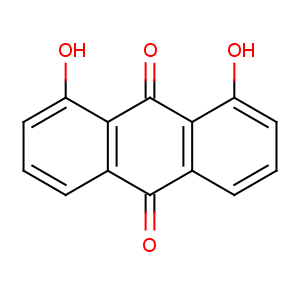Title: Danthron
CAS Registry Number: 117-10-2
CAS Name: 1,8-Dihydroxy-9,10-anthracenedione
Synonyms: 1,8-dihydroxyanthraquinone; 1,8-Dihydroxyanthraquinone; chrysazin; dantron
Trademarks: Altan; Antrapurol; Diaquone; Istizin (Winthrop); Modane (Adria)
Molecular Formula: C14H8O4
Molecular Weight: 240.21
Percent Composition: C 70.00%, H 3.36%, O 26.64%
Literature References: Prepn. Fierz-David, Blangey,
Farbenchemie (Vienna, 5th ed., 1943) pp 224-225; Kozlov,
Dokl. Akad. Nauk SSSR 61, 281 (1948). Clinical trial with poloxalkol in constipation: L. Mundow,
Br. J. Clin. Pract. 29, 95 (1975). Mutation study: J. P. Brown, R. J. Brown,
Mutat. Res. 40, 203 (1976). Toxicology: M. T. Case
et al., Drug Chem. Toxicol. 1, 89 (1977). Review of toxicity and carcinogenic risk:
IARC Monographs 50, 265-275 (1990).
Properties: Orange needles from alc, mp 193-197°. Sublimes. Absorption max: 430, 250 nm (log e 4.35, 4.60). Almost insol in water (6.5 ′ 10-6 mols/l at 25°), in alcohol (1:2000). Moderately sol in ether (1:500), in chloroform; sol in 10 parts hot glacial acetic acid. Very slightly sol in aq solns of alkali hydroxides: about 0.8 g dissolves in 100 ml 0.5
N NaOH. (Disodium salt is reported to have a water soly of 0.05%.) LD50 orally in mice: <7 g/kg (Case).
Melting point: mp 193-197°
Absorption maximum: Absorption max: 430, 250 nm (log e 4.35, 4.60)
Toxicity data: LD50 orally in mice: <7 g/kg (Case)
CAUTION: This substance is reasonably anticipated to be a human carcinogen:
Report on Carcinogens, Eleventh Edition (PB2005-104914, 2004) p III-77.
Use: Important intermediate in the manuf of alizarin and indanthrene dyestuffs; forms insol Ca, Ba, Pb lakes. Antioxidant in synthetic lubricants; fungicide.
Therap-Cat: Cathartic.
Therap-Cat-Vet: Purgative.
Keywords: Laxative/Cathartic.

